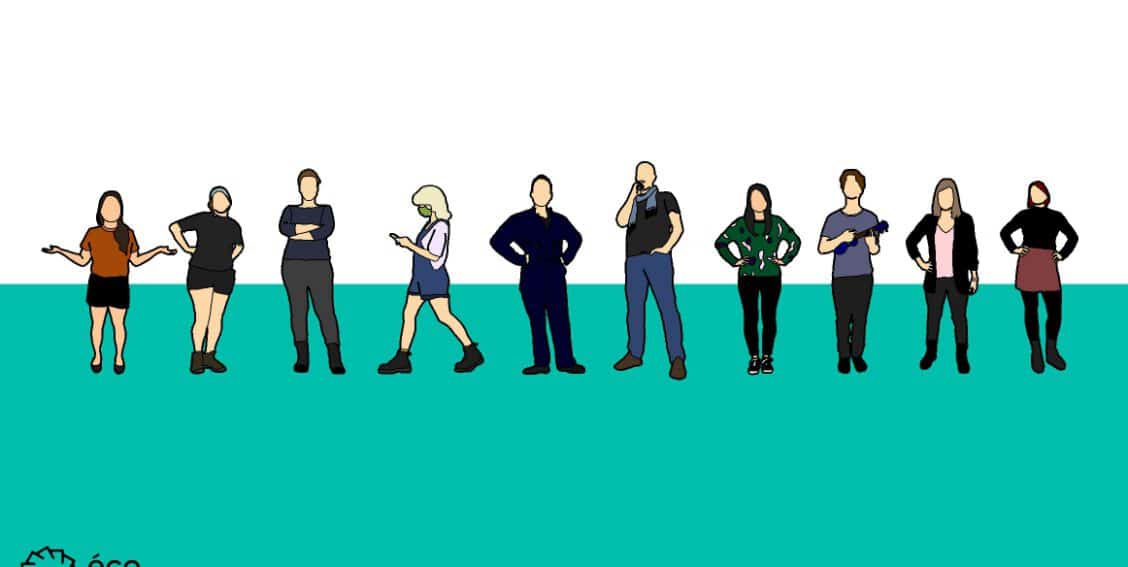If you’ve been following the work of Écoscéno for some time, you’ve probably noticed the pervasiveness of the SketchUp program on our online store, during our workshops, or for our team portraits.
In this blog, I would like to tell you the story of this love story. This story began in the summer of 2020, when Martin Gagné of 33 Degrés gave us the idea of modeling part of our inventory. We were immediately thrilled with this prospect, since it would be a first in the circular economy. From then on, I followed a SketchUp refresher course with the wonderful 33 Degrés Professor Marie-Ève Turcotte.
A modeled inventory
Our first project using SketchUp followed on December 4, with the launch of the models section on our online store:

The idea behind this modeled inventory is to encourage the reuse of the material by facilitating the work of the scenographers. Since it is estimated that 80% of a project’s impact and 70% of its environmental costs can be determined during design, supporting designers in eco-design is a priority. We looked into how to achieve this without imposing additional work on the scenographers. Our hypothesis: one possible solution is based on the 3D modeling of our inventory. As the scenic elements received at Écoscéno are unique, these models save a lot of time for the design team. With a few clicks, it’s easy to manipulate the scenic elements in a current work plan and identify if they are adequate. By making these unique elements accessible, models have the potential to reduce the purchase of new materials without having to go back and forth and take measurements at our warehouse. By facilitating access to the reuse of the material, we’re hoping that scenographers’ creativity and time will be applied to reuse in an innovative way, rather than going back and forth and buying new materials!
With reuse, it’s all in the details

The second-hand market presents a colossal challenge, but one that’s very motivating to solve: inventories are fluctuating, varied, and often objects bear marks of their past lives. When the materials arrive at Écoscéno, they have sometimes had 1, 2… 5 previous uses and the alterations that come with it. For example, this wooden platform has four holes on each side. These holes can be disturbing for a setting close to the public. Just like my colleagues who take care to describe the items on our online store as meticulously as possible, it is important for me to list these details to avoid unpleasant surprises. In the case of the platform we are interested in, listing the holes allows for a production to schedule the application of a suitable finishing product in time.
Ultimately, the ideal would be for downloading our models to become a reflex at the start of the design, to form the habit of checking whether there is already an element to be saved which could fulfill one of the production’s functions. At the same time, it would be great if Écoscéno received the SketchUp models of the sets at the same time they are brought to our warehouse. If productions systematically shared their SketchUp plans, more elements would end up on our platform and resources would flow better and faster!
Reuse, a constraint?
More recently, in May 2021, we took the question of SketchUp’s potential even further. My colleague Julie and I offered the “Reuse Creativity” workshop, where we invited designers to rethink the way they create. As a team, they were challenged to create, not from the blank page, but from a small inventory, taken from the play Les enfants:

Through a series of constraints (inventory, staging, time, assembly), the participants created sets in 30 minutes. The results show that if creating from what already exists is a constraint, it is inspiring! The scenographies obtained are completely different from each other and it is not the ideas that were lacking. Here are 4 examples:

Contact us if you would like to participate in the next edition of this workshop!
The humans behind Écoscéno
Last but not least, our third project is our team portrait! Those familiar with SketchUp already know that when a new document is opened, there is always a character serving as a reference scale. We have reproduced this model at Écoscéno, so all of our models are accompanied by a different member of our team.

Ce que seuls les pros de l’application savent déjà, c’est que ces personnages sont des composants et qu’ils ont tous des descriptions! SketchUp a fait la blague avec ses personnages, en cliquant sur Mark ou Stacy, vous en apprendrez plus sur leur vie personnelle. Et bien, vous pouvez en faire autant avec les membres de l’équipe d’Écoscéno! L’une de nous aime les grenouilles, une autre le reggaeton… apprenez qui à force d’utiliser nos modèles ????
